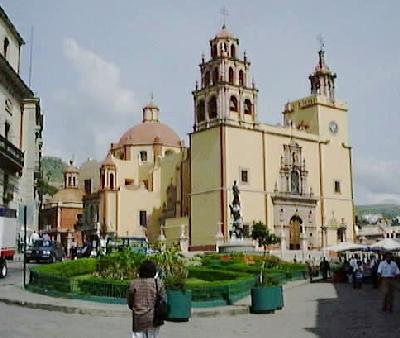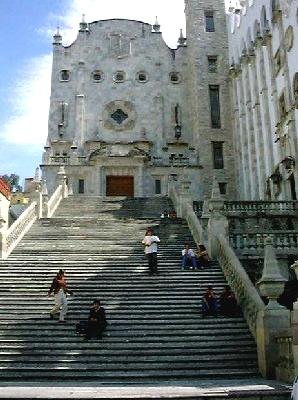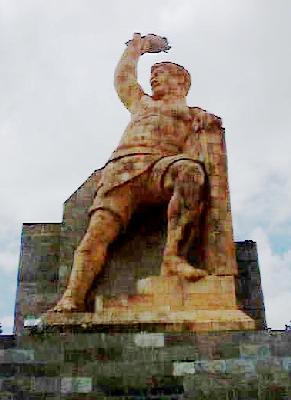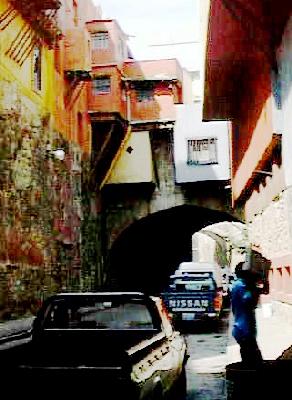
Guanajuato, Mexico

Guanajuato from the Pipila monument
Tuesday 24th - Friday 27th August 1999
We originally decided to come to Guanajuato from Zacatecas simply as a way of breaking up our journey into reasonable lengths, since Mexico is a very large country (almost 2 million square kilometres. However, as soon as we had arrived and checked into a hotel, we realised that it was a good decision. There's something about the atmosphere of Guanajuato that is a delight to visitors. In part it's the beautiful colonial architecture crammed on to the side of a mountain; in part it's the lively, bustling feel of the place. In any event, we both immediately felt that we wanted to stop for a few days here, rather than just the one day break we had anticipated.
On the first night, we arrived late and stayed at a dingy hotel where the room smelt like something had died. I discovered the reason for the smell when I flushed the toilet - it leaked, and rather than fix the leak, the owners had put a drain into the floor of the toilet. We immediately decided to find somewhere else to stay for the next night, and we succeeded in style by staying at the Hotel Kloster, a beautiful, friendly little place in the centre of town, very convenient for exploring.

Plaza de la Paz, Guanajuato
Guanajuato is a university town, and with students making up 15% of the population, it has a very youthful, lively air about it in the evening. The social heart of the city is the Jardin de la Union. Here there is a bandstand surrounded by carefully sculpted trees and benches, with restaurants and bars around them. At one end of the Jardin sits the beautiful Teatro Juarez, and throughout the evening musicians entertain the crowds and serenade couples (for a small fee, of course), competing with each other to provide the liveliest performance. People just sit on one of the benches and watch the world go by, stroll around or just stand and talk to their friends.
One evening we came across some chemistry students apparently celebrating the start of their first year. A large number of them were sitting on the steps in front of the Theatre being entertained by a group of musicians playing Mexican songs with much gusto and enthusiasm. Before long, we were swept up with the crowd as it started to follow the musicians around the town, through the narrow steep alleys known as Callejones, and the mobile music sessions are known as callejonades. Eventually the whole crowd ended up on the steps of the university (see below) until the musicians stopped playing after about two and a half hours.

University of Guanajuato
Another Guanajuato tradition concerns Callejon de beso (Kiss Alley), the narrowest callejon in the town. Here the buildings on either side are so close together that the story is that lovers living on different sides would kiss each other from the opposite balconies. Supposedly a couple who kiss on the third step will have fifteen years of happiness together. Needless to say Veronika and I made sure we did this 8-)
Guanajuato also played an important part in the Mexican war of independence, as it was the site of the first victory of the independence movement. On September 28th 1810, a crowd laid siege to the Alhondiga, the base of the Spanish forces in the area. The well-defended barracks held out until Juan Jose de los Reyes Martinez, El Pipila, a young Indian miner, set fire to the gates at the cost of his life, allowing the 20,000 rebels to capture the base and defeat the Spanish. A statue of El Pipila, the Monumento al Pipila, dominates one of the hills overlooking the city.

Monumento al Pipila, Guanajuato
One of the strange features of Guanajuato is the underground streets which criss-cross the town, and ensure that the old town is not swamped with traffic, unlike Zacatecas. Some of the bus stops are underground, and there are steps up to street level for pedestrians getting on and off. Many of the streets were built on the bed of the Rio Guanajuato which was diverted after it flooded much of the town in 1905. Today there are many signs on the side of buildings marking the level of the inundacion, most of them above head height.

Part of an underground street in Guanajuato
Guanajuato also has a number of museums. The university has a smallish but interesting natural history museum with a collection of stuffed animals and insects, with the strangest of all being a stuffed two-headed goat, which I assume was a freak of nature and not some sort of traditional Mexican breed. There is also a museum devoted to artwork relating to Don Quijote de la Mancha, Cervantes' famous hero. Every year there is a Cervantes festival held in Guanajuato in October.
However, the prize for the strangest museum has to go to the Museo de los Momias (Museum of the Mummies). This rather bizarre, slightly unnerving museum houses 119 bodies disinterred from the public cemetery. The mineral content of the soil and the dry atmosphere combine to mummify the bodies buried here in as little as five or six years. When the public cemetery started to fill up in 1865, the local authorities dug up the bodies of those whose families were unwilling or unable to pay a fee to keep their dead relatives in the ground. This still goes on to this day, although only 1 or 2% of the bodies turn in to "display quality" mummies; the rest are cremated. The gruesome museum is very popular with Mexicans and makes for an interesting if slightly unpleasant visit. "Highlights" include the world's smallest mummy, the first mummy discovered and a mummified foetus - the story is that a woman discovered she was pregnant and committed suicide out of shame; when they disinterred her corpse, only the foetus had been mummified. A strange place indeed.
Mexico index | Travel index | Family history | Romany | Main index